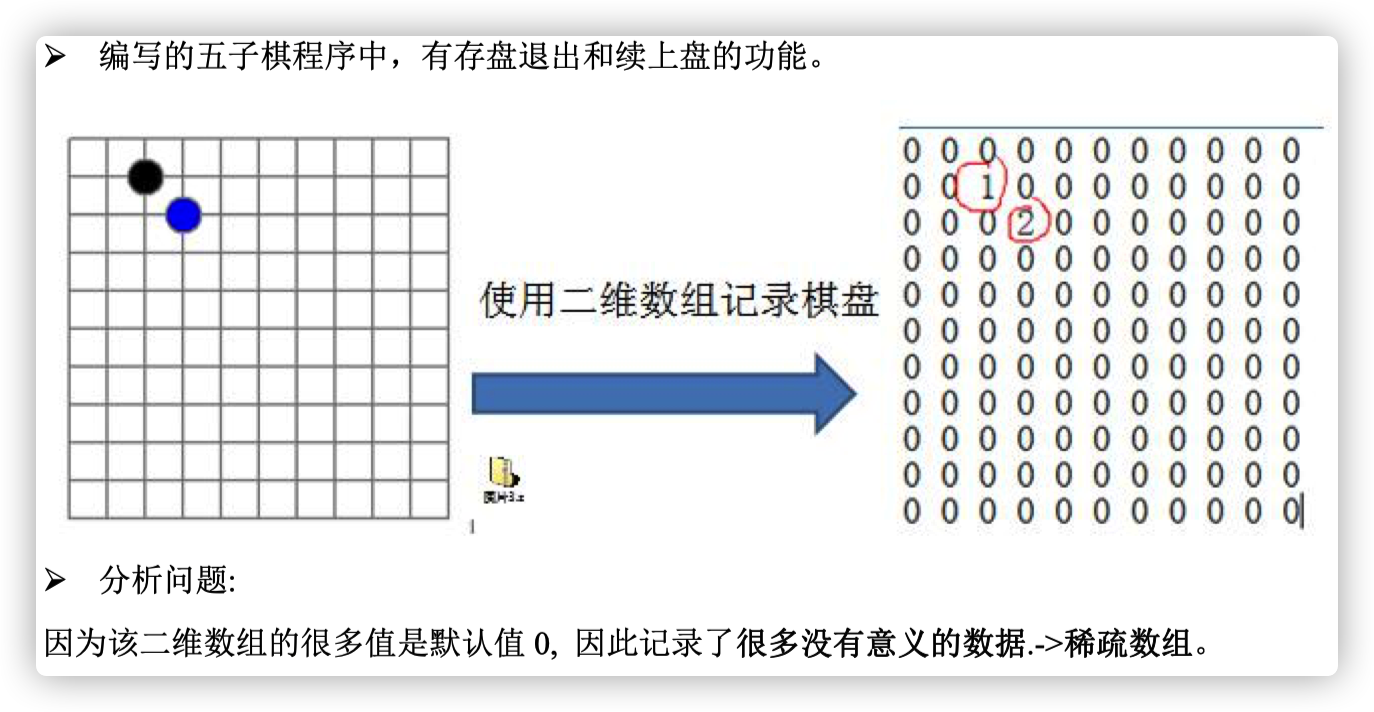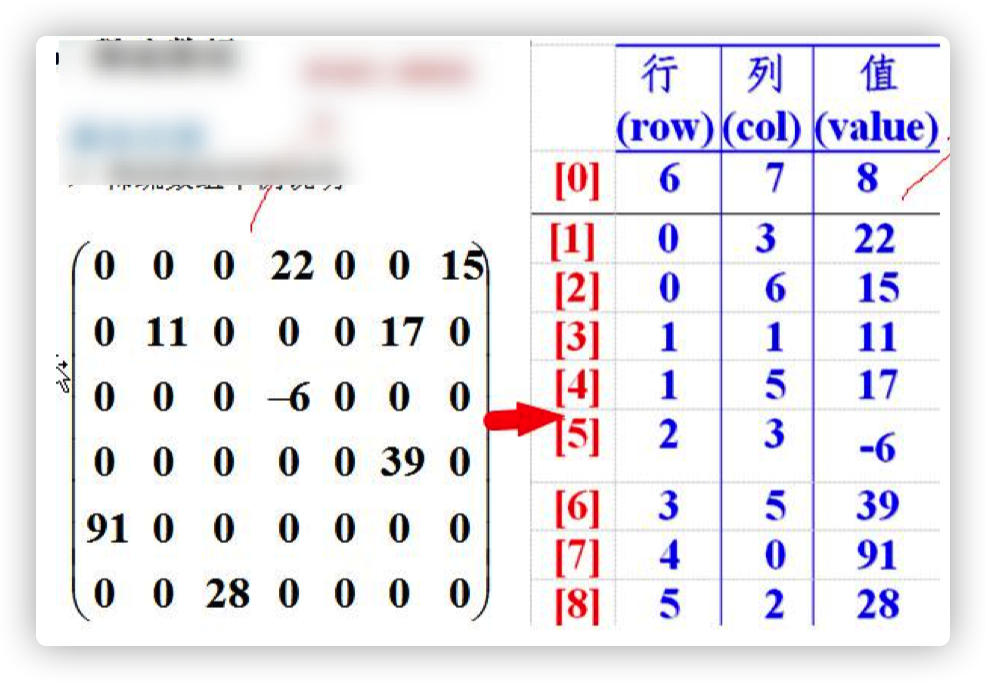1、需求场景
- 当二维数组的大部分值是默认值0的时候,可以考虑使用稀疏数组,譬如:

2、二维数组转换为稀疏数组
思路分析
- 记录数组有m行n列,有p个非零值--->对应到稀疏数组的第0行(遍历原始数组)
- 在稀疏数组中,记录原数组的非零值的行列坐标(x, y)和数值v---> 从第一行分别往下列出

3、稀疏数组还原为二维数组
- 由稀疏数组的第一行----->得到原始数组的行列数,就可以确定数组的大小
- 读取剩余的行,就可以填充原始数组。
4、例题实现
- 将二维数组转换为稀疏数组,然后存储到磁盘,实现棋盘的保存功能;
- 读取磁盘文件,恢复成为原来的棋盘,实现续上盘的功能;

public class ExerciseArr {
public static void main(String[] args) {
int[][] chessArray = initArray();
int[][] sparseArray = ArrayToSparseArray(chessArray);
storeToDisk(sparseArray);
int[][] readFromDisk = readFromDisk();
for (int[] row : readFromDisk) {
for (int i : row) {
System.out.print(i + " ");
}
System.out.println();
}
}
/**
* 初始化一个二维数组(代表前盘)
* @return 初始化的数组
*/
public static int[][] initArray(){
int[][] chessArr = new int[11][11];
chessArr[1][2] = 1;
chessArr[2][3] = 2;
return chessArr;
}
/**
* 棋盘数组--->稀疏数组
* @param chessArray 棋盘数组
* @return 稀疏数组
*/
public static int[][] ArrayToSparseArray(int[][] chessArray){
//遍历棋盘数组,统计非零元素个数
int sum = 0;
for (int[] row : chessArray) {
for (int data : row) {
if (data != 0)
sum++;
}
}
//创建稀疏数组,填充第一行
int[][] sparseArray = new int[sum+1][3];
sparseArray[0][0] = 11;
sparseArray[0][1] = 11;
sparseArray[0][2] = sum;
//稀疏数组,填充其余行
int sparseRow = 1;
for (int i = 0; i < chessArray.length; i++) {
for (int j = 0; j < 11; j++) {
if (chessArray[i][j] != 0){
sparseArray[sparseRow][0] = i;
sparseArray[sparseRow][1] = j;
sparseArray[sparseRow++][2] = chessArray[i][j];
}
}
}
return sparseArray;
}
/**
* 稀疏数组--->棋盘数组
* @param sparseArray 稀疏数组
* @return 棋盘数组
*/
public static int[][] sparseArrayToArray(int[][] sparseArray){
int[][] array = new int[sparseArray[0][0]][sparseArray[0][1]];
for (int i = 1; i <sparseArray.length; i++) {
array[sparseArray[i][0]][sparseArray[i][1]]=sparseArray[i][2];
}
return array;
}
/**
* 用数据流DataOutputStream将数据写出到硬盘
* @param sparseArray 稀疏数组
*/
public static void storeToDisk(int[][] sparseArray) {
//造流
DataOutputStream dos = null;
try {
dos = new DataOutputStream(new FileOutputStream(new File("storeArray.txt")));
//遍历数组,写入文件
for (int[] row : sparseArray) {
for (int data : row) {
dos.writeInt(data);
}
}
dos.flush();
} catch (IOException e) {
e.printStackTrace();
} finally {
try {
if (dos != null) {
dos.close();
}
} catch (IOException e) {
e.printStackTrace();
}
}
}
public static int[][] readFromDisk() {
DataInputStream dis = null;
int[][] sparseArray = new int[0][];
try {
dis = new DataInputStream(new FileInputStream("storeArray.txt"));
sparseArray = new int[3][3];
for (int i = 0; i < sparseArray.length; i++) {
for (int j = 0; j < sparseArray[0].length; j++) {
sparseArray[i][j] = dis.readInt();
}
}
} catch (IOException e) {
e.printStackTrace();
} finally {
try {
if (dis != null) {
dis.close();
}
} catch (IOException e) {
e.printStackTrace();
}
}
return sparseArray;
}
}


